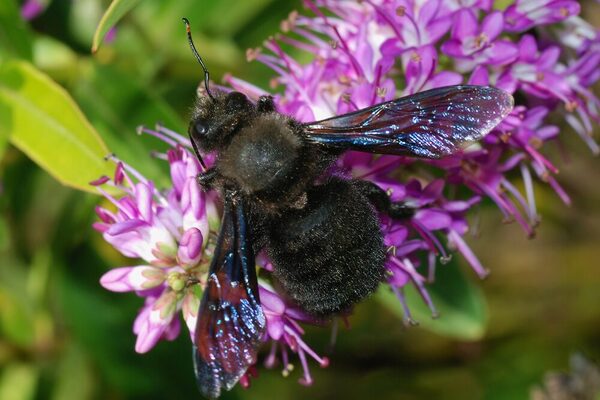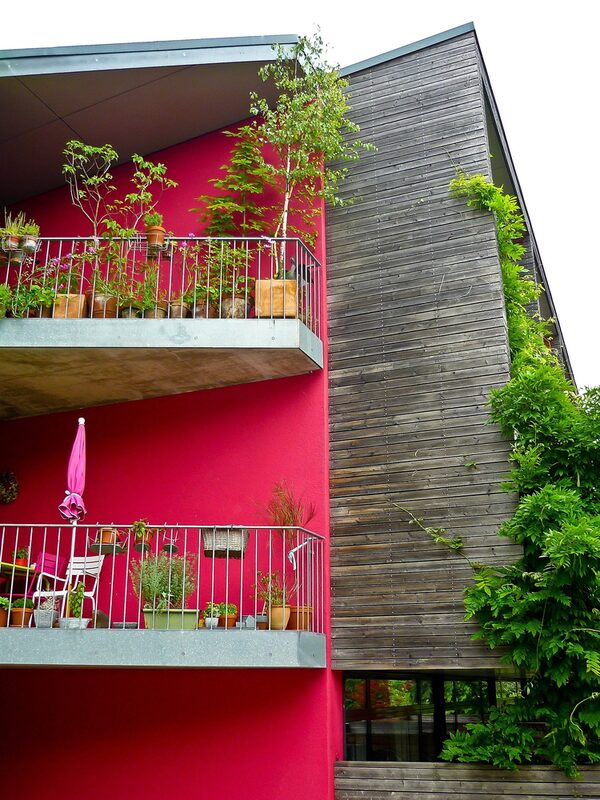Wild bees
Over 560 different species of wild bees can be found in Germany. All species are subject to special species protection. The animals may not be caught, injured or killed. Their nests are also protected. Exceptions to this principle must be approved by the Lower Nature Conservation Authority.
Threatened with extinction
Many wild bees have become rare because they lack suitable nesting sites and food. This is due to tidy cultivated landscapes, monotonous fields and gardens and the use of pesticides.
According to the "Red List of Threatened Animals, Plants and Fungi" (as of February 2011), over 52 percent of the bee species recorded in Germany are endangered. 25 of these endangered species are threatened with extinction.
Many species - different appearance and lifestyle
Wild bees come in different sizes and colors.
The smallest wild bee in Germany is the sand steppe bee, which is only four millimetres in size. The largest, at three centimetres, is the large blue wood bee. Formerly only rarely visible in Wiesbaden, it is now frequently seen. As a warmth-loving species, it benefits from the higher average temperatures associated with climate change.
Some species are tied to the occurrence of a specific plant species, others are flexible in their search for food. The specialists among the bees are acutely threatened if "their" plant disappears from the location.
The many different bee species build a wide variety of nests. They dig holes in the ground, gnaw cavities into the pith of plant stems or use existing cavities. Some species build their nests on a solid base, using resin, plant fibers or sand mixed with saliva as building material. The vast majority of bee species nest underground.
On cold and damp spring days, when neither honeybees nor other insects fly out, it is the densely haired bumblebees that still pollinate the flowers.
Most bee species do not form colonies, but live alone (solitary).
Bees are pure herbivores
Bees cover their own energy requirements almost exclusively from the sugary nectar of flowering plants. They collect the pollen as food for their larvae. Quite "incidentally", bees pollinate the flowering plants while foraging. This enables fruit and seed formation. Around 80 percent of our flowering plants are dependent on pollination by insects. Bees do a large part of this. This secures the food supply for many living creatures, including humans. They are also an important part of the food chain and serve as food for other animals such as birds, reptiles and mammals.
A life for the next generation
Over the course of the year, social bumblebees enlarge their nests and thus their colony. In the fall, the colony dies and only the new queens that have grown up overwinter in order to build a new colony the following year. Between 50 and 500 animals live in a bumblebee colony.
The situation is different for solitary species. The lifespan of the females is usually limited to four to six weeks. During this time, they can only produce around 20 to 40 offspring.
From egg to finished insect
The development of bees, from egg to flying insect, takes place in brood cells. Nectar and pollen serve as a food supply. Cuckoo bees smuggle their eggs into the nests of other species and their larvae develop there at the expense of the host larvae.
Do wild bees sting?
In most bee species, the females have a "defensive sting". However, almost all species are extremely peaceful and only defend themselves if they are directly harassed. Often their stingers cannot even penetrate human skin.
Only colony-forming bumblebees occasionally defend their nest in a way that is clearly noticeable to us. However, the sting of a bumblebee is not comparable to that of a honeybee. Unlike bees, a bumblebee sting does not get stuck in human skin. The amount of venom used by the bumblebee is also considerably less than that of a honeybee. The bite of a bumblebee is not a typical defense reaction.
Frequently asked questions in bee consulting
Most people like bees. However, especially when large numbers of bees gather in one place, there are also questions.
"Sand/wall bees"
With the onset of spring, the Environment Agency occasionally receives reports of swarms of bees on unvegetated mounds of earth or on house facades.
These are usually solitary bee species. They fly around their nesting sites, which are located in holes in the façade or in the ground. Favorable site conditions can lead to the formation of loose nesting communities. Within these, each queen takes care of her offspring alone.
If young animals hatch from the tunnels, they are initially males. They wait in front of the brood tubes for the females to appear.
These animals behave very peacefully. The situation resolves itself within a short time. Any action against the animals would be completely inappropriate and is therefore not permitted.
Bumblebees
If bumblebees have settled in the garden, no defensive reactions are to be expected if they are kept at a safe distance of 1-2 meters from the nest entrance. If bumblebees feel threatened, they can defend themselves by stinging. Different bumblebee species are irritable in different ways. Tree bumblebees sting the fastest. This is because they build their nests more openly than other species. As a result, they are more likely to be attacked.
Bumblebees like to build their nests underground. If children or pets live on the property, the nest can be surrounded by a screen to prevent confrontations. Some bumblebee species dissolve their colony in June/July. Nests of other species can remain alive until the fall.
If problems arise with a bumblebee nest despite protection, relocation may be an option. However, this is particularly complicated in the case of ground nests, as the nests often branch out widely.
Like all "wild bees", bumblebees are under special species protection.
Honey bees
Honey bees swarm in May and June. You can find out who to contact if you come across a swarm of bees on the page about honey bees.
Do you want to do something good for bees and other animals?
Every garden and balcony user can make a contribution to preserving insect diversity, even in a small space. You will find suggestions for implementation in the attached documents.
Further information
Documents
Contact us
Species protection advice
Address
65189 Wiesbaden
Postal address
65029 Wiesbaden
Arrival
Notes on public transport
Bus stop Statistisches Bundesamt; bus lines 16, 22, 27, 28, 37, 45, X26, x72, 262
Telephone
- +49 611 313733
- +49 611 313957
Information on accessibility
- Barrier-free access is available
- The WC is barrier-free

